Confusing Spring Caterpilars in Cranberry (1999)
In Massachusetts, a number of different caterpillars attack cranberry vines in May and June. Sweep-netting should be employed to detect insect activity on a bog. Early season sweeping activity, to catch the pest population before larvae are large, is key. Some of the most damaging species found are the cutworms, false armyworm and cranberry blossomworm. Humped green fruitworm and gypsy moth counts should be added to the cutworm count. If the numbers are greater than 4 to 5, on average, for 25 sweeps, a management strategy should be considered. For green and brown spanworm, the threshold is an average of 18 larvae, in 25 sweeps.
Bacillus thuringiensis (B.t.) based products are effective against cutworms and spanworms when they are small. Larger caterpillars are much harder to control by any type of spray. Late water is a very effective tool for false armyworm and cranberry blossomworm management. A heavy uniform layer of sand reduces green spanworm populations.
Also keep in mind that sparganothis fruitworm and black- headed fireworm may be picked up in spring sweeping. Because of their webbing behavior and their potential for considerable damage, after an average of 1 to 2 sparganothis fruitworm or black-headed fireworm is found, management strategies should be considered. Correct identification of insects on your bog is critical for proper management. Check the current Cranberry Chart Book and other fact sheets for more details.
False Armyworm
Xylena nupera (Lintner)
Lepidoptera: Noctuidae
The newly hatched caterpillars may be difficult to correctly identify. Newly hatched larvae are grayish-green and have
small dots that bear slender black hairs, but these hairs are only visible under magnification. Very young larvae are slender like spanworms and have a characteristic way of crawling (looping) like a spanworm. As they grow, young false armyworms may superficially look like green spanworms. Use a 10x lens to correctly identify very small caterpillars. First instar and very young false armyworm larvae have 3 or 4 pairs of legs on their mid-section and hind end (whereas green spanworms have only 2 pairs of legs on the hind end).
Once they reach about 6-7 mm (0.25"), the caterpillars are green with a yellow stripe down each side and have 5 distinct pairs of fleshy legs on the mid-section and hind end. At this size, they no longer use the looping crawl seen in the younger caterpillars. As they become larger, 12 mm (0.5") or so, they typically have white lines along the body and are lime green, often being lighter on the bottom portion of the body compared to the upper portion. They are large bodied, almost bloated-looking caterpillars. They will get up to 51 mm (2") long when mature. Caterpillars vary considerably in coloring as they become larger as the upper portion of the body ranges from apple green to black.

Young false armyworm larvae. On left, tiny first-instar false armyworm has black dots bearing spines and moves with a looping crawl. The larva (center) continues a looping-type crawl until its abdominal prolegs are fully developed (right). Medium and large false armyworm larvae. Mature larvae may vary from green to black.

Blossomworm larvae (left and center) are a distinctive purplish color. Humped green fruitworm (right) is apple green with a hump on its back end.
Young cutworm caterpillars often do great harm by eating out the hearts of the terminal buds before new growth starts. They develop with the new vine growth and feed more and more voraciously as they mature, devouring leaves, buds, and flowers. They feed freely in the daytime as young caterpillars. Similar to other cutworms, they do not web the vines. As they mature, the larvae feed at night and hide during the day. As a result, they will no longer be picked up in your day sweeps. By the end of June, all mature caterpillars have completed development and emerge as moths later in the summer. These moths overwinter and lay masses of eggs in the spring.
Cranberry Blossomworm
Epiglaea apiata (Grote)
Lepidoptera: Noctuidae
Early hatched larvae are greenish with portions of the body pinkish-reddish-purplish tinged. Like false armyworms, small caterpillars crawl by looping until older and larger, over 9 mm (0.4"). Larger larvae are usually completely pinkish-reddish with a white stripe along the side and may be over 38 mm (1.5") when mature. The five pairs of hind legs are easily distinguished from the two pairs of hind legs that spanworms have.
Young caterpillars feed on leaves and terminal buds starting in May. Older caterpillars may cut off flower pods and blossoms. When they are half grown they become night active. The moths fly during harvest and lay eggs that overwinter on the bog. The eggs hatch the following May.
Humped Green Fruitworm
Amphipyra pyramidoides (Guenee)
Lepidoptera: Noctuidae
Also known as "Pyramidal Fruitworm"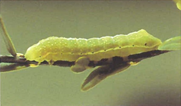
The caterpillar of the humped green fruitworm is similar to false armyworm but has a prominent hump that develops as the caterpillars reaches its third molt, or is 8-12 mm (0.3-0.5") long. The humped green fruitworm caterpillar is apple green and has a continuous white line running down its back and a bold yellow line along a portion of its side.
Unlike blossomworm and false armyworm, humped green fruitworm may feed during the day even as a large caterpillar. When mature, the body length may be up to 38 mm (1.5").
This caterpillar appears sporadically, almost always in small numbers. It feeds in a manner similar to false armyworm and cranberry blossomworm and should be counted along with these when scouting with a sweep net. It does not feed on cranberry fruit. The moths of humped green fruitworm fly during harvest and lay eggs that overwinter on the bog.
Gypsy Moth
Lymantria dispar (Linnaeus)
Lepidoptera: Lymantriidae
When young, this is a very hairy, totally black caterpillar.
Intermediate-sized larvae are black with a chain of orange dots. Older caterpillars are covered with black hairs and have prominent red and blue bumps: 5 pairs of blue spots followed by 6 pairs of red spots. They have yellowish head capsules and may be 25-51 mm (1-2") long when mature.
The very long hairs on the newly hatched caterpillar's body make them buoyant. They suspend themselves from silken threads and are easily picked up by the wind and balloon into bogs from adj.acent infested woodlands. Thus, you often will have greater infestations of gypsy moth on the side of the bog closest to these infested woodlands. Gypsy moth eggs are laid in masses and are covered with light brown hairs from the abdomen of the female. These egg masses are laid by last year's females, who do not fly. Eggs will overwinter on the bog even under winter floods. The eggs hatch from mid to late April into May.
Male and female gypsy moth adults are dissimilar. The male is brown with bushy antennae. The female has far less bushy antennae and has nearly all-white wings. The moths emerge in July and August.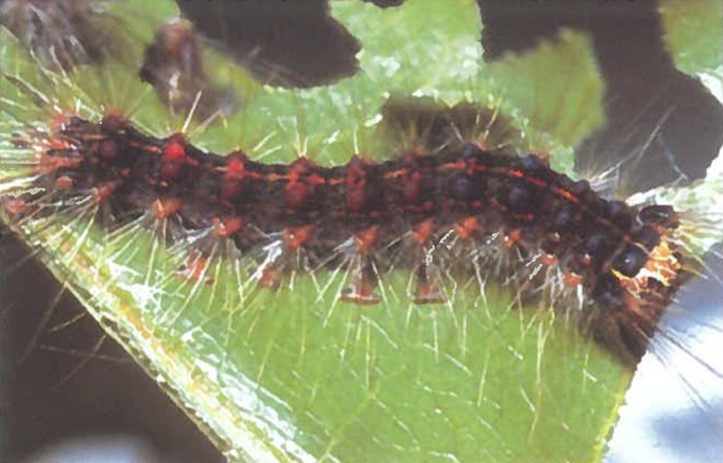
Large gypsy moth larvae, blue and red dots are prominent along the back.
Gypsy moth larvae feed on a wide variety of plants, including many forest and fruit trees. They appear sporadically. The young gypsy moth caterpillars eat the developing buds, and in sweep net counts, should be added to false armyworm and cranberry blossomworm numbers. As the caterpillar grows, it devours leaves, buds, and flowers. Infestations oflarvae often may occur in patches, so scouting with the net must be thorough. Also, older larvae become night active only and thus, will not be detected in later spring sweeps.

Gypsy moth adults. The male and female moths are very different. The male (left) is darker and smaller. The female (right) is mostly white.
She cannot fly and here, is pictured producing an egg mass. She covers the egg mass with hairs from her abdomen.
Spanworms
Another caterpillar family that attacks cranberry is called the spanworms, 'loopers,' or 'inchworms,' because of the way they move across a surface. They stretch out at full length, take hold with the front legs, and then bring forward the hind end close to the front pairs oflegs in a looping manner. This habit is due to the lack of several legs (that other caterpillars have) to support the middle of the body. The hind part has only two pairs of legs. These spanworms are much more slender than most caterpillars. They are hairless and feed openly, never webbing leaves together. When disturbed, they cling to their support by the hind pairs of legs and remain straight and motionless. The most important cranberry spanworms are green spanworm and brown spanworm.
Green Spamworm
Itame sulphurea (Packard)
Lepidoptera: Geometridae
These spanworms are greenwith several white lines along the back and sides and a narrow light yellow stripe alon each side. The larvae usually nip off flower buds and blossoms by severing the stem. When extremely abundant, they sometimes may cause brown discoloration on a small area of bog.
The body of older spanworm caterpillars is more slender than that of false armyworm and cranberry blossomworm. Mature caterpillars stop feeding when they are about an inch long and pupate in the trash layer around mid-June.
Overwintering eggs hatch from May 15 to June 1, a little later than most cutworms. The larvae complete development from about June 10 until after mid-July. The moths emerge in July and tend to fly less than brown spanworm. Green spanworm moths are yellow with a brown fringe on their wings. Females scatter their eggs among the trash litter under the vines.
It is good to know the moths of green and brown spanworm because there may be some overlap in the flight periods of adults: as always, proper identification is key to management success. Green spanworm is a larger moth than brown spanworm.

Green spanworm eggs (left) are scattered singly in the trash layer of the bog where they overwinter. Green spanworm larvae (center) have only two pairs of hind legs. Green spanworm moths (right) are mostly yellow and fly predominantly in July.
Spiny Looper/Half-Wing Geometer
Phigalia titea (Cramer)
Lepidoptera: Geometridae
On cranberry, the larvae feed from the leaves of new growth,
down to the old growth and then move to adjacent areas of new growth. Some larvae nip the stem of the new shoots, which fall over. In areas of older feeding, browned tips are obvious. Patchy areas of feeding and larval aggregation are highly characteristic.
The seasonal history has not been studied on cranberry. On forest trees in Virginia and West Virginia, there is a single generation and winter is spent in the pupal stage in the soil. Adults emerge in the early spring and climb vertical surfaces. Males appear several days to a week before females and rest on tree trunks. Mating occurred on tree trunks, after which females climbed upward to locate oviposition sites, usually dead twigs. In western Massachusetts, the typical light colored male moth (which is cryptically colored when resting on birch trees) occurs as well as a melanic form, which is entirely blackish.
The larvae are reported to be active in May and June. To date, in an accelerated year (1998) we observed a dense aggregation on a bog edge in May. At such high densities, we could only conclude that the overwintering pupal stage was able to survive on the bog.
Patches of larvae within a bog have also been observed by growers on bogs. Females do not fly, so it is possible that, in these cases, each patch is made up of the progeny of a single female. She would have ballooned to the bog from the uplands as a first instar larva, completed larval development, overwintered as a pupa, attracted a male for mating, and laid her eggs.
Larvae feeding on cranberry were observed to complete development and burrow into sand to pupate in the first week of June. Full-grown larvae are violet, pinkish-gray brown with many blackish longitudinal lines and are about 37 mm (1.5") long.

Spiny looper larvae feeding on new growth.
The male moth has a wingspread of 37 mm (I .5''). The thorax is whitish and the abdomen is marked with two rows of black dots on the dorsum. The forewings are dotted with dark brown specks and are marked with three blackish lines and a row of black spots along the outer margin. Females are cryptically colored and are virtually wingless. The females do not fly. The female is ash gray with no obvious markings. Her wings, which are about 3 mm (> 1/8") long, are vestigial and functionless. Females are seldom detected.
First instars actively balloon, and ride the air currents to new sites. They hang on silk lines below the dead twigs on which eggs have been laid. This would be the most likely way that a cranberry bog would become infested. There are five larval instars.
Other Cranberry Spamworms
There are a number of other species of spanworm that are seen on cranberry bogs in different years. They appear mostly in May and June. They can generally be counted in with green and brown spanworms. Sometimes, localized in circular patches, they can be quite damaging. Scout early and visually inspect the vine areas where they are known to be a problem. Larger larvae hold onto the vine and may be hard to detect while sweeping.
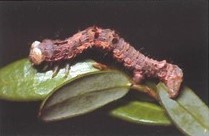
One of the several unidentified species of cranberry spanworm larva.
Brown Spamworm
Ematurga amitaria (Guenee)
Lepidoptera: Geometridae
The young larvae are light brown with a whitish stripe along each side and another along the middle of the back. Full grown larvae appear in late July and are a little over an inch long, and are usually grayish brown. Larvae may vary considerably in shade, sometimes being a darker brown. Some larvae will have indefinite markings in later instars, with more or less pronounced stripes.
Pupae overwinter in the leaf litter on the bog and some moths emerge in late May with most emerging in the first weeks of June. The moth is light gray, dully variegated with rusty brown. The wings spread about 25 mm (l"). The moths will flutter around while you are sweeping; this should be a "heads-up" to be especially careful when sweeping for larvae, and extend sweeping into bloom. However, larval populations are not always established following observation of moth flight.
Female moths lay eggs in June in clusters ofup to 20 in the leaf litter of the bog floor. These eggs begin to hatch in mid-June, much later than cutworms or green spanworms. Brown spanworm larvae are particularly tricky to control with pesticides because their late-spring appearance coincides with the placement of bee hives onto the bogs.
B.t. products are a good spray option, but require good coverage and may require two or more treatments. Infestations can be severe, and larval populations can reach very high numbers. Populations of brown spanworm can be patchy, and where larval populations are unchecked, areas where all bloom has been destroyed can be seen. Larvae will also chew on small berries and the damaged areas will form brown patches on the berry as it enlarges. Brown spanworm is resistant to some insecticides.
As brown spanworm larvae get larger, they are less likely to be picked up in the sweep net. This is a result of a behavior where some larvae cling halfway down the stem of the upright during mid-day, rather than up on the leaves.

(Left) Small brown spanworm larva. (Center) Brown spanworm larvae. (Right) Brown spanworm moths: female on left, male on right.
Great Cranberry Spamworm or Big Cranberry Spamworm
Eutrapela clemataria (J.E. Smith)
Lepidoptera: Geometridae
The caterpillars are almost black at first, but as they grow they become chocolate brown. The mature larva is fully 64 mm (2.5") long. Most of its surface is very smooth. A noticeable dark ridge bearing a few low bumps crosses the back opposite the second pair of legs.
Great cranberry spanworm overwinters as a pupa, and the moths emerge late in May. The moth is light gray, marked with rusty brown. The wings spread about 51 mm (2"). Egg clusters, which may containl 00's of eggs, hatch toward mid-June. The larvae mature and pupate in July. They prefer to sever the flower buds and blossoms. There is one generation a year.
This species, which usually occurs in distinct patches, can be particularly destructive on rare occasions. Spot treating with a backpack sprayer has been highly effective, and saves treating larger acreage that is not heavily infested. Because of the large size that these larvae attain, their sweep net count should be counted like cutworms.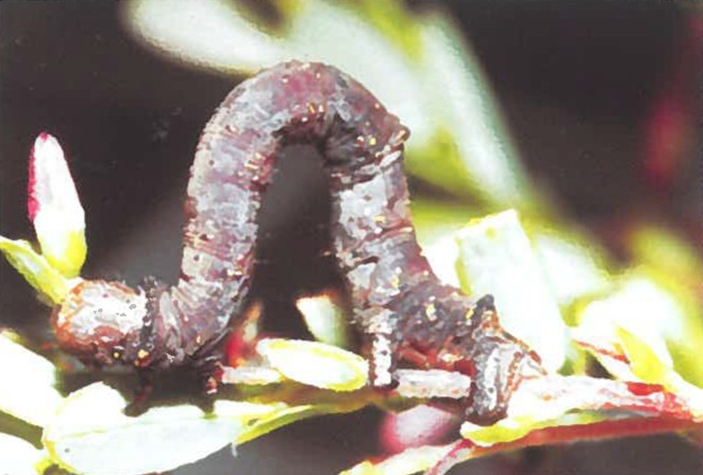
Big cranberry spanworm larva.
Cranberry Sawfly
Pristiphora idiota (Norton)
Hymtmoptera: Tenthredinidae
It is important to distinguish this group from key pests as it does little damage and should not be counted. Most young larvae are yellowish green and become darker green as they mature, growing to 12 mm (0.5'') long. The larva has six pairs of legs on the back end and three pairs on the front. The underside looks like continuous legs. The head capsule is greenish-brown, is very distinct and quite round. The larva tends to curl up when held. From the top view the front legs of sawflies are more splayed out from the body when compared to the other insects shown here.
The larvae feed on the leaves and the damage appears as irregular scalloping of the leaf edge. The larvae overwinter in an oval cocoon made of tough, dark brown silk. The adults emerge in May and females lay eggs in the edges of leaves by making a pocket within the upper and lower surfaces.
Cranberry sawfly has several generations, lays eggs in the leaf, clips leaves and undergoes a lengthy development. A number of generations appear through the season, with the last generation completing larval development by the end of September.
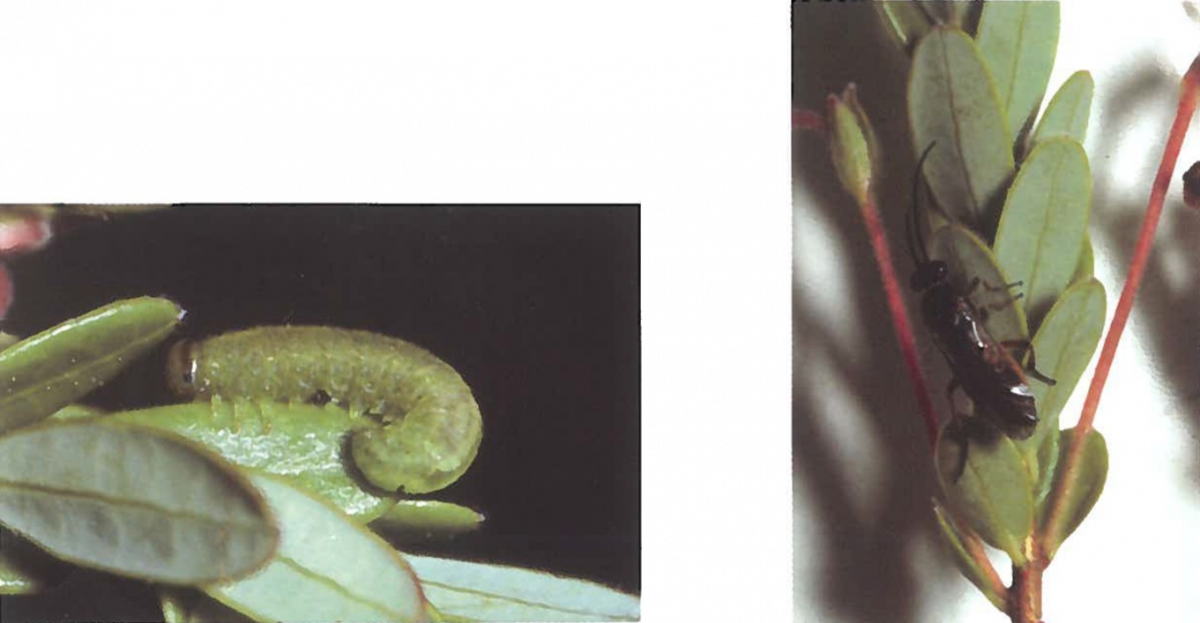
Cranberry sawfly larva. The larva is somewhat similar in color to the false armyworm larva but has a rounded head capsule, more legs, and a distinct curling behavior (left). The adult sawfly is like a wasp and is black with yellow areas (right).
Other species of sawflies can also be picked up. The color may vary. They may be light red, apple green with prickly green spines, or bi-colored with dingy olive green on the upper part of the body and lighter green on the bottom. In these cases, there are also six or seven pairs of legs on the back end but they may be much larger than cranberry sawfly, over 12 mm (0.5'') long.
Unlike all the other insects on this sheet, the adult is not a moth, but is a sawfly. The adult is about 5 mm (0.2") long. Sawflies are in the same insect order that includes bees, wasps, and ants. Rarely are high numbers of sawflies seen in bogs and they are not known to cause significant damage in small to medium numbers.
These insects should not be included in your false armyworm, blossomworm, gypsy moth sweep counts.
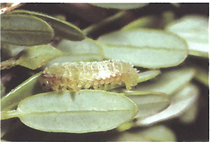
Another species of sawfly (not cranberry sawfly), that along with other unknown species, may be common on some bogs.